Extended Data Figure 4. K2P modulator pocket structure and conservation.
Details of a, ML335, and b, ML402 interactions with K2P2.1(TREK-1). c and d, Representative K2P channel sequence comparisons for the c, M4 face and d, P1 face. Purple bar and orange shading on sequence identifiers denotes the thermo- and mechanosensitive K2P2.1(TREK-1) subfamily. Protein secondary structure is marked above the sequences. Selectivity filter region is in red. Residues involved in direct interactions with ML335 and ML402 are orange and marked with an orange asterisk. Conserved positions are highlighted. K2P2.1(TREK-1) is the mouse protein used for this study. K2P2.1H(TREK-1) is the human homolog. All other K2P sequences are human origin. Sequences and identifiers are as follows: K2P2.1(TREK-1) NP_034737.2; K2P2.1H(TREK-1), NP_001017424.1; K2P10.1(TREK-2), NP_612190.1; K2P4.1(TRAAK), NP_001304019.1; K2P3.1(TASK-1), NP_002237.1; K2P9.1(TASK-3), NP_001269463.1; K2P5.1(TASK-2), NP_003731.1; K2P1.1(TWIK-1), NP_002236.103812.2; K2P6.1(TWIK-2), NP_004823.1; K2P7.1(KCNK7), AAI03812.2; K2P16.1(TALK-1), NP_001128577.1; K2P17.1(TALK-2), NP_113648.2; K2P12.1(THIK-2), NP_071338.1; K2P12.1(THIK-1), NP_071337.2; K2P15.1(TASK-5), NP_071753.2; and K2P18.1(TRESK), NP_862823.1. ‘●’ in K2P16.1(TALK-1) sequence in ‘c’ denotes the following, non-conserved sequence that was removed to avoid a long alignment gap: NFITPSGLLPSQEPFQTPHGKPESQQIP.

